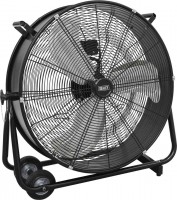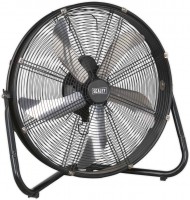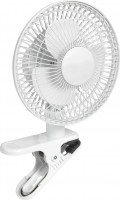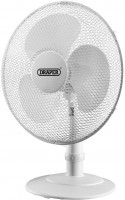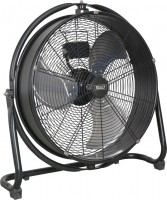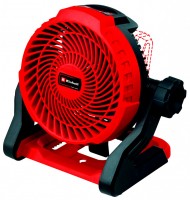Fans FARO
All Fans Advanced filters → |
You might be interested in
Fans: specifications, types
Type
— Desktop. Small models designed to be placed on a tabletop. Usually, they have low power and are designed primarily for the person directly sitting at the table. Among those, there are also portable options ( mini-fans), which are not powered by the mains and are available for use not only on the desktop.
— Floor. Fans intended for installation on the floor. There are two types. Floor fans without stand...are distinguished by the large diameter of the blades and high power, and also cannot adjust the direction and always blow in one direction. Floor standing — a classic version of home ones, which also have large blades located at a height of more than a metre from the floor and can rotate around the stand, which allows you to ventilate the entire room.
— Wall mounted. Fans equipped with special brackets that allow them to be mounted on the wall. The power of such fans is comparable to floor fans, and the advantage is that their installation does not require free space on the floor, which can be critical in small areas. On the other hand, wall mounting is much more complicated than floor mounting.
— Floor/table (2 in 1). Transformer models adapted for use as a floor or table fan. The implementation of their design may be different. The vast majority of such fans are equipped with a stand for placement on a desktop and a stand with a base for floor installation.
— Universal 3 in 1. Universal models can transform for use as a floor, desktop or wall fan, which can be useful when used in confined spaces. The implementation of the design itself may be different, but usually, a stand for placement on a table, a wall mount and a stand with a base for floor placement are included.
— Ceiling. With the help of a special mounting, this type of fan is installed directly under the ceiling, has large blades and has high performance. It is one of the most efficient types of fan, able to provide excellent airflow, and, in winter, such a device directs warm air downwards.
— Floor. Fans intended for installation on the floor. There are two types. Floor fans without stand...are distinguished by the large diameter of the blades and high power, and also cannot adjust the direction and always blow in one direction. Floor standing — a classic version of home ones, which also have large blades located at a height of more than a metre from the floor and can rotate around the stand, which allows you to ventilate the entire room.
— Wall mounted. Fans equipped with special brackets that allow them to be mounted on the wall. The power of such fans is comparable to floor fans, and the advantage is that their installation does not require free space on the floor, which can be critical in small areas. On the other hand, wall mounting is much more complicated than floor mounting.
— Floor/table (2 in 1). Transformer models adapted for use as a floor or table fan. The implementation of their design may be different. The vast majority of such fans are equipped with a stand for placement on a desktop and a stand with a base for floor installation.
— Universal 3 in 1. Universal models can transform for use as a floor, desktop or wall fan, which can be useful when used in confined spaces. The implementation of the design itself may be different, but usually, a stand for placement on a table, a wall mount and a stand with a base for floor placement are included.
— Ceiling. With the help of a special mounting, this type of fan is installed directly under the ceiling, has large blades and has high performance. It is one of the most efficient types of fan, able to provide excellent airflow, and, in winter, such a device directs warm air downwards.
Power source
The presence of an autonomous way to power the device. Applicable for portable mini-fans, since stationary ones are powered by 230 V mains. There are two ways to feed:
- USB port. Models designed to be installed near the PC workplace. And it's not a problem to find a USB port, both in a PC, a laptop or a power bank.
- Battery. Portable models that do not need a power supply...and can be used even outdoors. The built-in battery allows them to work for a long time. Naturally, the power of such fans is small and, like any battery technology, they need to be recharged and can be discharged at the most unsuitable moment.
- USB port. Models designed to be installed near the PC workplace. And it's not a problem to find a USB port, both in a PC, a laptop or a power bank.
- Battery. Portable models that do not need a power supply...and can be used even outdoors. The built-in battery allows them to work for a long time. Naturally, the power of such fans is small and, like any battery technology, they need to be recharged and can be discharged at the most unsuitable moment.
Mechanism
Axial fans are called models of classical design — equipped with blades. Such models are simpler and cheaper, but less safe and not suitable for creating an extensive ventilation system. Radial fans are a bladed wheel hidden in a protective casing. Such designs are safer, but more complex and expensive.
Relatively recently, a third type of fan was created — rotorless. Such a device looks l...ike a ring on a stand. The ring is hollow from the inside; when the fan is running, air circulates inside, which, thanks to special slots, entrains air from outside, driving it through the ring. Unlike other types, rotorless fans create a smooth, uniform airflow without noticeable disturbances; moreover, they do not have any moving parts on the outside and are thus the safest. However, these devices are very expensive.
Relatively recently, a third type of fan was created — rotorless. Such a device looks l...ike a ring on a stand. The ring is hollow from the inside; when the fan is running, air circulates inside, which, thanks to special slots, entrains air from outside, driving it through the ring. Unlike other types, rotorless fans create a smooth, uniform airflow without noticeable disturbances; moreover, they do not have any moving parts on the outside and are thus the safest. However, these devices are very expensive.
Power consumption
The maximum power consumed by the fan during operation. The higher the power consumption, the higher, usually, the greater the airflow rate created by the fan, and, accordingly, the higher the performance of the device. On the other hand, power usually directly affects the price, all other things being equal.
Number of speeds
The number of preset speeds at which the fan blades can rotate. The rotation speed is usually set by pressing the corresponding button (in addition, there is also a stepless adjustment, see the relevant paragraph). Most modern models with step adjustment have three preset speeds.
Air flow
The maximum performance provided by the fan — that is, the maximum amount of air that it can pass through itself in an hour.
The air flow is selected by manufacturers, taking into account the area and, accordingly, the volume of the room for which the device is designed. For efficient operation, the device must be able to pass the entire volume of processed air through itself at least once per hour. At the same time, for models with the same area of the room, different performance pa...rameters can be claimed — accordingly, the processing speed and efficiency will differ.
Also, note that the recommended area of the room can be estimated by performance if the latter is not stated in the characteristics. For example, if the device provides 200 m³/h, this means that the volume of the room can be less than 200 m³, which, with a standard ceiling height of 2.5 m, gives an area of 200/2.5 = 80 m². And ideally, the area should be even 2-3 times smaller — that is, be about 25-40 m².
The air flow is selected by manufacturers, taking into account the area and, accordingly, the volume of the room for which the device is designed. For efficient operation, the device must be able to pass the entire volume of processed air through itself at least once per hour. At the same time, for models with the same area of the room, different performance pa...rameters can be claimed — accordingly, the processing speed and efficiency will differ.
Also, note that the recommended area of the room can be estimated by performance if the latter is not stated in the characteristics. For example, if the device provides 200 m³/h, this means that the volume of the room can be less than 200 m³, which, with a standard ceiling height of 2.5 m, gives an area of 200/2.5 = 80 m². And ideally, the area should be even 2-3 times smaller — that is, be about 25-40 m².




